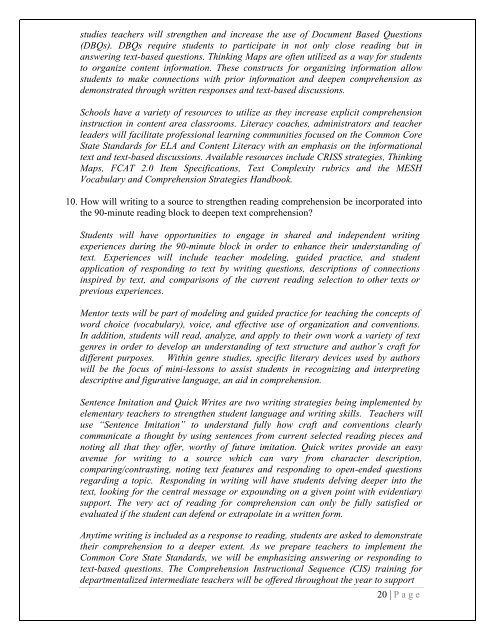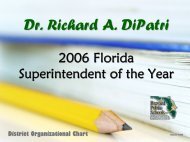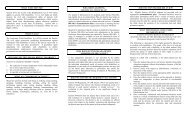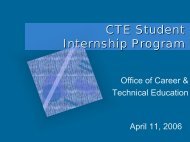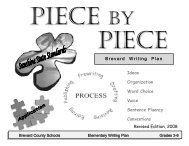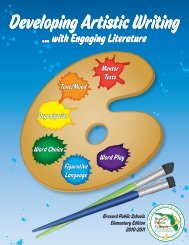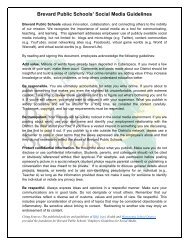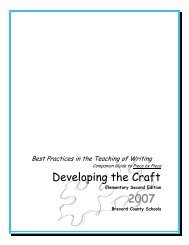2007-08 K-12 Comprehensive Research-Based Reading Plan
2007-08 K-12 Comprehensive Research-Based Reading Plan
2007-08 K-12 Comprehensive Research-Based Reading Plan
Create successful ePaper yourself
Turn your PDF publications into a flip-book with our unique Google optimized e-Paper software.
studies teachers will strengthen and increase the use of Document <strong>Based</strong> Questions(DBQs). DBQs require students to participate in not only close reading but inanswering text-based questions. Thinking Maps are often utilized as a way for studentsto organize content information. These constructs for organizing information allowstudents to make connections with prior information and deepen comprehension asdemonstrated through written responses and text-based discussions.Schools have a variety of resources to utilize as they increase explicit comprehensioninstruction in content area classrooms. Literacy coaches, administrators and teacherleaders will facilitate professional learning communities focused on the Common CoreState Standards for ELA and Content Literacy with an emphasis on the informationaltext and text-based discussions. Available resources include CRISS strategies, ThinkingMaps, FCAT 2.0 Item Specifications, Text Complexity rubrics and the MESHVocabulary and Comprehension Strategies Handbook.10. How will writing to a source to strengthen reading comprehension be incorporated intothe 90-minute reading block to deepen text comprehension?Students will have opportunities to engage in shared and independent writingexperiences during the 90-minute block in order to enhance their understanding oftext. Experiences will include teacher modeling, guided practice, and studentapplication of responding to text by writing questions, descriptions of connectionsinspired by text, and comparisons of the current reading selection to other texts orprevious experiences.Mentor texts will be part of modeling and guided practice for teaching the concepts ofword choice (vocabulary), voice, and effective use of organization and conventions.In addition, students will read, analyze, and apply to their own work a variety of textgenres in order to develop an understanding of text structure and author’s craft fordifferent purposes. Within genre studies, specific literary devices used by authorswill be the focus of mini-lessons to assist students in recognizing and interpretingdescriptive and figurative language, an aid in comprehension.Sentence Imitation and Quick Writes are two writing strategies being implemented byelementary teachers to strengthen student language and writing skills. Teachers willuse “Sentence Imitation” to understand fully how craft and conventions clearlycommunicate a thought by using sentences from current selected reading pieces andnoting all that they offer, worthy of future imitation. Quick writes provide an easyavenue for writing to a source which can vary from character description,comparing/contrasting, noting text features and responding to open-ended questionsregarding a topic. Responding in writing will have students delving deeper into thetext, looking for the central message or expounding on a given point with evidentiarysupport. The very act of reading for comprehension can only be fully satisfied orevaluated if the student can defend or extrapolate in a written form.Anytime writing is included as a response to reading, students are asked to demonstratetheir comprehension to a deeper extent. As we prepare teachers to implement theCommon Core State Standards, we will be emphasizing answering or responding totext-based questions. The Comprehension Instructional Sequence (CIS) training fordepartmentalized intermediate teachers will be offered throughout the year to support20 | P a g e


